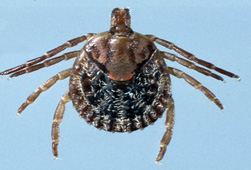This page has been archived and is being provided for reference purposes only. The page is no longer being updated, and therefore, links on the page may be invalid.
| Read the magazine story to find out more. |
|
|
|
|
Tick Responsible for Equine Piroplasmosis Outbreak Identified
By Sharon DurhamOctober 3, 2011
The cayenne tick has been identified as one of the vectors of equine piroplasmosis in horses in a 2009 Texas outbreak, according to U.S. Department of Agriculture (USDA) scientists.
The United States has been considered free from the disease since 1978, but sporadic cases have occurred in recent years. In October 2009, in Kleberg County, Texas, a mare was presented for veterinary care with clinical signs of infection, including poor appetite and weight loss. Subsequent investigation and testing confirmed the original case and indentified more than 290 additional infected animals on the ranch.
Research leader Donald Knowles, entomologist Glen Scoles and veterinary medical officer Massaro Ueti with the Agricultural Research Service (ARS) Animal Disease Research Unit, in Pullman, Wash., and collaborator Robert Mealey with Washington State University in Pullman have been working on the project with USDA's Animal and Plant Health Inspection Service (APHIS) and the Texas Animal Health Commission (TAHC).
ARS is USDA's principal intramural scientific research agency, and the research supports the USDA priority of promoting international food security.
The researchers' goal was to assess and prevent the spread of the Texas outbreak, which could have serious international trade implications if it is found to have spread beyond the ranch where the outbreak occurred. Part of their initiative was to identify the tick species responsible for the new outbreak.
Only two U.S. tick species—Dermacentor variabilis and Rhipicephalus (Boophilus) microplus—had previously been shown experimentally to be vectors of Theileria equi, the microbe that causes equine piroplasmosis, according to Scoles.
The cayenne tick, Amblyomma cajennense, had not previously been shown to be a competent vector. Adult cayenne ticks were collected from positive horses on the outbreak ranch and allowed to re-attach and feed on a noninfected horse. Scoles led the study showing these ticks successfully transmitted T. equi. The results will be published in the October issue of Emerging Infectious Diseases.
Knowles, Ueti and Mealey are treating some of the South Texas horses with imidocarb dipropionate. Tests conducted thus far by the team have been promising and trials are ongoing.
Read more about this research in the October 2011 issue of Agricultural Research magazine.

